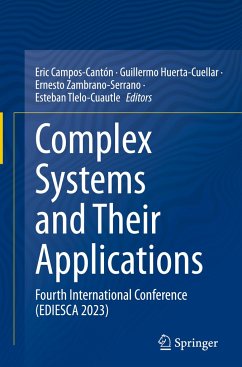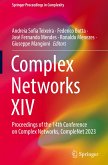Complex Systems and Their Applications
Fourth International Conference (EDIESCA 2023)
Herausgegeben:Campos-Cantón, Eric; Huerta-Cuellar, Guillermo; Zambrano-Serrano, Ernesto; Tlelo-Cuautle, Esteban
Complex Systems and Their Applications
Fourth International Conference (EDIESCA 2023)
Herausgegeben:Campos-Cantón, Eric; Huerta-Cuellar, Guillermo; Zambrano-Serrano, Ernesto; Tlelo-Cuautle, Esteban
- Gebundenes Buch
- Merkliste
- Auf die Merkliste
- Bewerten Bewerten
- Teilen
- Produkt teilen
- Produkterinnerung
- Produkterinnerung
This book is a compilation of scientific articles written by recognized researchers participating in the Fourth Conference on the Study of Complex Systems and their Applications (EDIESCA 2023), held in Monterrey, Mexico. EDIESCA arose from the need for academic and research groups that carry out this scientific research to disseminate their results internationally. The study and characterization of systems with non-linear and/or chaotic behavior has been of great interest to researchers around the world, for which many important results have been obtained with various applications. The dynamic…mehr
Andere Kunden interessierten sich auch für
![Complex Systems and Their Applications Complex Systems and Their Applications]() Complex Systems and Their Applications149,99 €
Complex Systems and Their Applications149,99 €![Complex Systems and Their Applications Complex Systems and Their Applications]() Complex Systems and Their Applications149,99 €
Complex Systems and Their Applications149,99 €![Chaos Chaos]() Otto E. RösslerChaos112,99 €
Otto E. RösslerChaos112,99 €![Chaos Chaos]() Otto E. RösslerChaos112,99 €
Otto E. RösslerChaos112,99 €![Complex Networks XIV Complex Networks XIV]() Complex Networks XIV149,99 €
Complex Networks XIV149,99 €![Complex Networks XIV Complex Networks XIV]() Complex Networks XIV149,99 €
Complex Networks XIV149,99 €![Dissipative Structures and Chaos Dissipative Structures and Chaos]() Hazime MoriDissipative Structures and Chaos38,99 €
Hazime MoriDissipative Structures and Chaos38,99 €-
-
-
This book is a compilation of scientific articles written by recognized researchers participating in the Fourth Conference on the Study of Complex Systems and their Applications (EDIESCA 2023), held in Monterrey, Mexico. EDIESCA arose from the need for academic and research groups that carry out this scientific research to disseminate their results internationally. The study and characterization of systems with non-linear and/or chaotic behavior has been of great interest to researchers around the world, for which many important results have been obtained with various applications. The dynamic study of chaotic oscillators of different models, such as Rössler, Lorenz, and Chua, has generated important advances in the understanding of chemical reactions, meteorological behavior, design of electronic devices, and other applications. Topics at the event included applications for communications systems by masking techniques, financial behavior, networks analysis, nonlinear lasers,numerical modeling, electronic design, and other interesting topics in the area of complex systems. Additionally, there are results on numerical simulation and electronic designs to generate complex dynamic behaviors.
Produktdetails
- Produktdetails
- Verlag: Springer / Springer Nature Switzerland / Springer, Berlin
- Artikelnr. des Verlages: 978-3-031-51223-0
- 2024
- Seitenzahl: 376
- Erscheinungstermin: 9. März 2024
- Englisch
- Abmessung: 241mm x 160mm x 25mm
- Gewicht: 797g
- ISBN-13: 9783031512230
- ISBN-10: 3031512235
- Artikelnr.: 69495986
- Herstellerkennzeichnung
- Springer Nature c/o IBS
- Benzstrasse 21
- 48619 Heek
- Tanja.Keller@springer.com
- Verlag: Springer / Springer Nature Switzerland / Springer, Berlin
- Artikelnr. des Verlages: 978-3-031-51223-0
- 2024
- Seitenzahl: 376
- Erscheinungstermin: 9. März 2024
- Englisch
- Abmessung: 241mm x 160mm x 25mm
- Gewicht: 797g
- ISBN-13: 9783031512230
- ISBN-10: 3031512235
- Artikelnr.: 69495986
- Herstellerkennzeichnung
- Springer Nature c/o IBS
- Benzstrasse 21
- 48619 Heek
- Tanja.Keller@springer.com
Eric Campos Cantón received his B.Sc., M.Sc. and Ph.D. degrees from Universidad Autónoma de San Luis Potosí (UASLP) México, in 1997, 1999 and 2003, respectively. In 2010 he was appointed as Professor-Researcher at IPICYT. He has been Visiting Researcher in the department of Mathematics at University of Houston, USA. He serves as Associate Editor in Journal of Applied Nonlinear Dynamics, Complexity and Mathematical Problems in Engineering. He has coedited a conference book "Complex Systems and Their Applications", Springer. He has thirteen international patents and his research interests include dynamical systems with chaotic behavior, in which he has the following lines of research: Analysis and modeling of dynamical systems in continuous and discrete time with chaotic behavior; Application of dynamical systems in cryptology; Experimental implementations of mathematical models with nonlinear and chaotic dynamics. Guillermo Huerta Cuellar received a B.Sc. degree fromInstituto de Investigación en Comunicaciones Ópticas, from the Universidad Autónoma de San Luis Potosí, México in 2004. He received a Ph.D. degree from Centro de Investigaciones en Óptica, León Guanajuato, Mexico, in 2009. From 2010 to the present he has been working at the Exact Sciences and Technology Department in Centro Universitario de los Lagos, Universidad de Guadalajara. He has been Visiting Researcher in the Department of Theory of Oscillations and Automatic Control, Faculty of Radiophysics, Lobachevsky State University of Nizhny Novgorod, Russia, and Department of Physics and Environmental Science at St. Mary's University, San Antonio, TX, US. He is editor of 4 books and more than 70 high-impact publications. His research interests include study, characterization, dynamical behavior, and design in nonlinear dynamical systems such as lasers, electronics, and numerical models. Ernesto Zambrano-Serrano received both B.Sc. and M.Sc. degrees from Benemérita Universidad Autónoma de Puebla (BUAP), Mexico, in 2009 and 2012 respectively. He then received a Ph.D. degree from Instituto Potosino de Investigación Científica y Tecnológica (IPICYT), Mexico in 2017. He is with Facultad de Ingeniería Mecánica y Eléctrica de la Universidad Autónoma de Nuevo León. He has edited special issues and participated as editor in several international journals. He is reviewer in Nonlinear Dynamics, Entropy, Applied Mathematics and Computation, Entropy, Complexity, International Journal of Dynamics and Control, and Mathematics Problems in Engineering, Mathematics. His research interests include chaotic behavior, nonlinear circuits, complex networks, fractional-order dynamical systems, stability, control and synchronization. Esteban Tlelo-Cuautle received his PhD degree from INAOE in 2000. He is appointed at INAOE from 2001. He has authored 5 books, edited 12 books, and published more than 300 works in journals, book chapters and conference proceedings. He servesas Associate Editor in: Engineering Applications of Artificial intelligence, Fractal and fractional, Int J. of Circuit Theory and Applications, IEEE Trans on Circuits and Systems I: Regular Papers, Integration - the VLSI Journal, and MDPI Electronics. His research focuses on: integrated circuit design and synthesis, artificial intelligence, design and applications of (fractional-order) chaotic systems, symbolic circuit analysis, modeling and simulation of circuits and systems, optimization by metaheuristics, and analog/RF and mixed-signal design automation tools.
Part 1: Artificial Intelligence Applied to Dynamics and Complexity.- Chapter 1. Classification of Chaotic Dynamics Through Time-Frequency Representations and Machine Learning.- Chapter 2. Optimization of echo state neural networks to solve classification problems.- Chapter 3. Deep Learning in the Expansion of the Urban Spot.- Part 2: Biomedical Advancements in Rehabilitation Through Complex Systems.- Chapter 4. Solving Inverse Kinematics Problem for Manipulator Robots Using Artificial Neural Network with Varied Dataset Formats.- Chapter 5. CRNN-based Classification of EMG Signals for the Rehabilitation of the Human Arm.- Chapter 6. LMI-based Design of a Robust Affine Control law for the Position Control of a Knee Exoskeleton Robot: Comparative Analysis of Stability Conditions.- Chapter 7. Position Control of Robotic Systems via Linear Controllers with Application to a Lower Limb Rehabilitation Exoskeleton Robot: Design and Comparative Analysis.- Part 3: Controlling Dynamical and Complex Systems.- Chapter 8. Synchronization of memristive Hindmarsh-Rose neurons connected by memristive synapses.- Chapter 9. A systematic approach for Multi-switching compound synchronization of non-identical chaotic systems using optimal control.- Chapter 10. Limit Cycle Generation by Inducing the Controllable Hopf Bifurcation.- Chapter 11. Cascading Timers: The new method to Solve the Sequential Problems Including Timers in Automation Systems.- Chapter 12. Mixed Sensitivity Control of Euler-Lagrange Models.- Part 4: Applications of Chaotic and Complex Systems.- Chapter 13. A New 4-D Four-Scroll Hyperchaotic System with Multistability, Coexisting Attractors and its Circuit Realization.- Chapter 14. Secure Communication System Based on Multi-Stability: Evaluation using the SCAMPER Method for Innovation Projects.- Chapter 15. An Image Compression and Encryption Approach with Convolutional Layers, Two Dimensional Sparse Recovery and Chaotic Dynamics.- Chapter 16. Comparative study of the viscoelastic behavior on PLA filaments, a fractional calculus approach.- Chapter 17. A New 4-D Highly Chaotic Two-Scroll System with a Hyperbola of Equilibrium Points and its Circuit Simulation.
Part 1: Artificial Intelligence Applied to Dynamics and Complexity.- Chapter 1. Classification of Chaotic Dynamics Through Time-Frequency Representations and Machine Learning.- Chapter 2. Optimization of echo state neural networks to solve classification problems.- Chapter 3. Deep Learning in the Expansion of the Urban Spot.- Part 2: Biomedical Advancements in Rehabilitation Through Complex Systems.- Chapter 4. Solving Inverse Kinematics Problem for Manipulator Robots Using Artificial Neural Network with Varied Dataset Formats.- Chapter 5. CRNN-based Classification of EMG Signals for the Rehabilitation of the Human Arm.- Chapter 6. LMI-based Design of a Robust Affine Control law for the Position Control of a Knee Exoskeleton Robot: Comparative Analysis of Stability Conditions.- Chapter 7. Position Control of Robotic Systems via Linear Controllers with Application to a Lower Limb Rehabilitation Exoskeleton Robot: Design and Comparative Analysis.- Part 3: Controlling Dynamical and Complex Systems.- Chapter 8. Synchronization of memristive Hindmarsh-Rose neurons connected by memristive synapses.- Chapter 9. A systematic approach for Multi-switching compound synchronization of non-identical chaotic systems using optimal control.- Chapter 10. Limit Cycle Generation by Inducing the Controllable Hopf Bifurcation.- Chapter 11. Cascading Timers: The new method to Solve the Sequential Problems Including Timers in Automation Systems.- Chapter 12. Mixed Sensitivity Control of Euler-Lagrange Models.- Part 4: Applications of Chaotic and Complex Systems.- Chapter 13. A New 4-D Four-Scroll Hyperchaotic System with Multistability, Coexisting Attractors and its Circuit Realization.- Chapter 14. Secure Communication System Based on Multi-Stability: Evaluation using the SCAMPER Method for Innovation Projects.- Chapter 15. An Image Compression and Encryption Approach with Convolutional Layers, Two Dimensional Sparse Recovery and Chaotic Dynamics.- Chapter 16. Comparative study of the viscoelastic behavior on PLA filaments, a fractional calculus approach.- Chapter 17. A New 4-D Highly Chaotic Two-Scroll System with a Hyperbola of Equilibrium Points and its Circuit Simulation.








